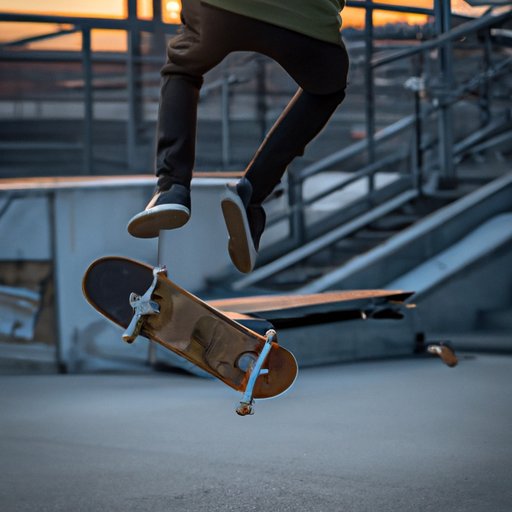
Introduction
If you’re looking to pick up a new hobby, skateboarding is a fun and exciting option that can easily be enjoyed solo or with friends. In this article, we’ll provide a comprehensive guide for beginners interested in mastering skateboarding. Whether you’re a complete novice or looking to improve your existing skills, this article will offer valuable tips, techniques, and safety precautions to help you along the way.
5 Simple Steps to Master Skateboarding for Beginners
Before attempting any cool tricks or techniques, it’s important to start with the basics. Here are five simple steps to help you master skateboarding as a beginner:
Step 1: Getting comfortable on the board and finding your stance
Begin by testing both your left foot and right foot to see which feels more comfortable as your front foot and which feels better as your back foot. Once you’ve found your stance, stand on the board and get a feel for shifting your weight from front to back and side to side.
Step 2: Learning to push and maintain balance
Push off with one foot and maintain balance on the board with your other foot. Start by pushing off slowly until you feel comfortable going faster while maintaining balance. Keep your shoulders facing forward and your knees bent for stability.
Step 3: Practicing turning and carving
Turning and carving are important skills for navigating corners and curves. To turn left, place more pressure on the toes of your front foot and lean slightly in that direction. To turn right, place more pressure on the heel of your front foot and lean in the opposite direction.
Step 4: Mastering the ollie
The ollie is a fundamental trick that involves jumping with the board and bringing it off the ground. Start by getting comfortable jumping and landing while stationary, then practice this motion while rolling. Once you feel comfortable, ramp up the power to achieve higher ollies.
Step 5: Putting it all together and riding with confidence
Once you’ve mastered the basics, it’s time to combine everything and start practicing your technique consistently. The more you skate, the more comfortable you’ll become, and the more tricks you can try.
The Art of Skateboarding: Tips, Techniques, and Tricks
Now that you’ve got the basics down, it’s time to step up your skateboarding game with tips, techniques, and tricks:
Tips for improving balance and footwork
One of the essential aspects of skateboarding is maintaining balance and control. Practice standing on your tail and nose with one foot at a time to improve balance. Experiment with different footwork, such as switching up your stance or testing out different foot placements.
Techniques for executing basic tricks such as the kickflip and heelflip
Once you’ve mastered the ollie, it’s time to move on to basic tricks like the kickflip and heelflip. Watch tutorial videos online, and practice each motion slowly until it becomes muscle memory.
Creative ways to utilize obstacles and terrain
Skateboarders are known for their creativity in finding ways to use obstacles and terrain to their advantage. Experiment with jumps, rails, and curbs to develop new tricks and styles.
Skateboarding 101: Essential Gear and Safety Precautions
Skateboarding can be a dangerous sport, so it’s essential to take safety precautions:
Overview of necessary gear
Skateboarding requires a few essential pieces of gear, including a skateboard, appropriate shoes, and protective gear such as helmets, elbow pads, and knee pads. Make sure to invest in high-quality gear to protect yourself and help prevent injuries.
Discussion of safety measures
Wear a helmet at all times and avoid dangerous terrain. Respect other skaters and don’t show off your skills if it puts others at risk. Also, be sure to keep your gear up-to-date and in good repair.
The Science of Skateboarding: Understanding Physics and Momentum
Skateboarding isn’t just about looking cool, it also involves understanding basic physics and momentum:
Explanation of basic concepts
Gravity is the force that keeps you on your board, and friction controls your speed. You can use momentum to maintain speed and balance, and controlling your center of gravity is essential to maintaining stability.
Discussion of how these concepts can help skaters improve their technique and control
By understanding these basic principles, you can adjust your technique to improve control and performance. For example, shifting your weight and body position can affect your center of gravity to help you maintain balance while executing tricks.
From Skatepark to the Streets: How to Expand Your Skateboarding Skills
Once you’ve mastered the basics, it’s time to expand your skills:
Suggestions for taking your skateboarding beyond the skatepark
Try skateboarding in different types of terrain, such as street skating. Find new spots to skate and experiment with different obstacles to improve your skills and creativity.
Tips for improving street skating skills and staying safe in urban environments
When street skating, always pay attention to your surroundings and be aware of potential hazards such as cars or pedestrians. Start with simple tricks and gradually work your way up to more advanced maneuvers.
Ideas for further developing your style and creativity
Experiment with different techniques and styles to create your unique mode of skateboarding. Try to develop your tricks by mixing up common elements and creating novel moves. Listen to music, watch videos, and express your creativity through your skating.
Conclusion
Skateboarding is an exciting and challenging sport that can provide hours of fun and entertainment. Whether you’re new to skateboarding or looking to improve your skills, there’s always something new to learn. In this article, we’ve outlined the basic steps, techniques, and safety precautions you need to know.





